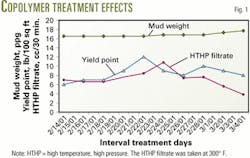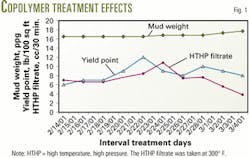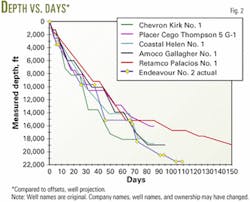Without hole problems and at high rates of penetration (ROP), ChevronTexaco Corp. successfully drilled a deep, hot South Texas well, named Endeavour No. 2, under high temperature, high-pressure (HTHP) conditions using a conventional diesel oil-base fluid.
Drilling to 21,500 ft with 480° F. bottomhole temperature is not easy under the best circumstances. Factor in the absence of equally deep offset wells, the last 6,000 ft of the well can become an HTHP guessing game.
In an area where every offset well was plagued by lost circulation, stuck pipe, and radical fluctuations in HTHP fluid-loss rates, the company's Endeavour No. 2 avoided these hole problems, even during long periods of rig repair and logging downtime.
One critical factor to the well's success was the process of testing drilling fluid samples for worst-case conditions in a drilling-fluids lab in nearby Alice, Tex. Drilling-fluid specialists assigned to the job were able to evaluate the potential for trouble and exercise preventive measures.
The use of efficient high-speed shakers and dual centrifuges was another key to maintaining the resilient mud system.
As a result of good preplanning and efficient solids control, the oil-mud system held up to frequent CO2 intrusions and extremely high bottomhole temperatures. Engineers and crews accomplished this with minimal intervention and at an acceptable cost.
Offset wells, red flags
Research on offset wells revealed a number of risks.
Despite intermediate casing shoe tests of up to 19.8 ppg, three offset wells studied encountered lost returns after displacing to oil-base fluid after the intermediate casing was set. One well lost 1,100 bbl of high density, oil-base fluid in 3 days.
As often happens, lost circulation led to stuck pipe and stuck logging tools. Though the operator was able to work free in each case, crews lost days fighting the situation. There were also CO2 contamination problems in the lower part of each offset well.
The drilling fluid reports from the offset wells noted repeated problems with fines, or colloidal solids, in the oil-base fluid.
Without high efficiency, solids-control capabilities, the only way to reduce fines and control rheological properties was to dilute the fluid with diesel. This increased the additions of barite (and in one case hematite), viscosifiers, fluid-loss control additives, and lost-circulation materials.
Drilling deeper
Endeavour No. 2 had a proposed TD that was several thousand feet deeper than the closest offsets. Well planners had only the following facts for guidance:
- The well would expose more open hole to drilling fluids, the drillstring, and drilling operations.
- Only heavier drilling fluid would control formation inflow.
- The wellbore would encounter higher temperatures.
- Longer trips would occur.
As the first line of defense, the company installed two high-speed shakers. Designed to handle high density, oil-base fluids with a minimum of blinding, these shakers were significantly more efficient and required less maintenance than the existing rig shakers.
Initially equipped with 210-mesh screens, as the well approached TD, engineers replaced the 210-mesh screens with ones of 250 mesh.
In addition to the shakers, engineers added two centrifuges to the solids control system, allowing for better removal of the troublesome ultra-fine solids that were reported on the offset wells.
Water base to oil base
A 14 3/4-in. bit drilled to 8,011 ft in the intermediate hole section, at which point the company made the decision to reduce the hole size to 12 1/4 in. due to slow penetration rates.
Drilled with a water-base lignosulfonate fluid, the rig reached the interval's TD at 9,713 ft, with an ending mud weight of 11.8 ppg. The average ROP through this interval was 27 fph. Crews ran and cemented the 10 3/4-in. intermediate casing string with no problems.
After setting and cementing the 10 3/4-in. intermediate casing, crews cleaned and filled the mud pits with 14.0 ppg diesel oil-base fluid in preparation for displacement prior to drilling out cement and testing the casing seat.
During the drilling out of the cement and testing the casing shoe, no oil-base fluid contamination or loss occurred.
The crew and rig drilled the next 5,500 ft at an average 44-fph ROP, nearly double the ROP in the previous interval, with a 9 3/8-in. bit. Pump repairs and problems with the downhole mud motor caused some delays.
After 7 days and 3,500 ft into this interval, the drilling fluids engineer began adding sized calcium carbonate to minimize seepage losses.
Immediately before reaching liner depth, it became necessary to treat the oil-base fluid with lime to counter CO2 intrusions and to enhance the fluid's temperature stability.
At this point, crews raised the mud weight to 16.4 ppg to suppress trip gas accumulation. The flowline temperature held steady at 170° F. A wireline log recorded the bottomhole temperature at the liner depth as 364° F.
Crews encountered no fill during any return to bottom during 7 days of tripping, logging, shooting sidewall cores, and running the 7 3/4-in. liner. The rig ran and cemented the 7 3/4-in. liner without incident.
Hot wellbore forecast
Knowing that the next hole interval would present the most challenging temperature increase, as well as require higher mud weights, the drilling fluids personnel began a series of predictive laboratory tests in the nearby Alice, Tex., laboratory.
Their goals were to ensure that the oil-base fluid emulsion remained stable and that the mud would control fluid loss at the desired level under extremely high temperatures (>400° F.).
Maintaining adequate rheological properties at surface was extremely important to prevent surface barite settling without dramatically increasing fluid properties downhole.
While oil-base mud has lower viscosity or "thins" at high temperature, fluid compressibility and downhole pressures overcome the effect and can actually increase fluid density and viscosity.
Increased rheological properties downhole increases equivalent circulating density (ECD), thereby placing additional pressure on the wellbore and formations, which can cause lost circulation. The margin for error on the well was small, however, considering that offset wells had experienced lost circulation.
Personnel had seen some barite settling in surface lines. They needed a method to maintain good downhole properties without experiencing the thinning effect resulting from substantially lower surface pressures.
While the operator was logging at liner depth, the Alice laboratory technicians compared current fluid samples to samples from the initial drilling fluid delivery to the location.
Current fluid samples showed a water volume increase and corresponding change in oil-water ratio (OWR). The electrical stability (ES) of the oil-base fluid, an indicator of emulsion stability, was slightly lower than it had been in the original fluid but remained within an acceptable range.
As the rig resumed drilling out from under the liner, drilling-fluid samples from the well were sent for analysis, using a FANN 75 direct-indicating viscometer, at 450° F. under a simulated bottomhole pressure of 16,000 psi.
Downhole, the well seemed stable. Rheological properties remained steady and acceptable for the mud weights required.
At the lab, technicians treated several samples with various filtrate reducers and viscosifiers and then compared them with the untreated samples from the wellsite to determine the best method for curbing fluid loss and preventing barite settling.
After a 16-hr static and dynamic aging interval, the technicians demonstrated that the addition of a rheology modifier would be necessary to maintain an adequate yield point to support 16.8-ppg fluid weight in the hot-wellbore conditions.
When tested in the laboratory, however, the standard oil-base fluid viscosifier, organophilic clay, raised the yield point to an unacceptable level and drilling-fluid personnel had to continue searching for other options.
The field samples had also shown higher than desirable fluid losses during the HTHP testing, which were quickly reduced by adding a copolymer filtrate-control agent.
Engineers expected the copolymer to perform well at 400° F., but it actually showed excellent performance up to 500° F.
The FANN 75 testing showed that the fluid-loss reduction additive also contributed to improved rheological properties at surface temperatures, with just a slight increase in downhole rheology. Adding this material to the active system raised the yield point only slightly, bringing an end to surface settling, and cut the HTHP filtrate results in half (Fig. 1).
This eliminated dependence on the standard oil-base fluid viscosifiers and allowed more flexibility in both rheology and fluid loss control.
At about 19,000 ft, it became necessary to increase lime additions and raise the mud weight to 16.8 ppg as CO2 intrusions became more frequent. Technicians increased the amount of lime in the system from about 4.0 lb/bbl to a steady 5.0 lb/bbl and maintained the lime at that level.
Durable, stable
Drilling-fluid personnel applying the lab findings and recommendations in the field eliminated the surface settling problems, and the drilling fluid remained stable at the desired oil-water ratio throughout the 6 1/2-in. hole interval.
Fig. 2 shows that the company drilled the Endeavour No. 2 deeper, at faster ROP, and avoided the hole problems that the three nearest offset wells had encountered.
CO2 intrusions continued occurring throughout the 6 1/2-in. interval. Drilling fluid personnel increased the mud weight to minimize contamination and reduce trip gas accumulation.
After drilling nearly a mile of 6 1/2-in. diameter hole without problems, operations stopped for logging and evaluation. The rig did not circulate the oil-base fluid for 50 hr during logging operations.
The drillstring encountered no fill or tight spots when returning to bottom to continue drilling an additional 1,000 ft of hole.
Tools measured a bottomhole temperature of 481° F. at the final logging point. Despite the heat and the long periods without circulation, the oil-base fluid remained in good condition and helped preserve wellbore integrity.
The drilling fluid for the Endeavour No. 2 was a conventional diesel oil-base fluid, run with a standard emulsifier package.
In the final hole section, with very high temperatures, mud weights between 16.5 and 17.5 ppg, and frequent CO2 intrusions, drilling-fluid personnel maintained the yield point between 10 and 15 lb/100 sq ft with no apparent settling.
Good solids-control equipment, timely laboratory analysis, and the judicious use of correct additives resulted in reasonable drilling fluid costs and whole mud losses that were very low.
The authors
Dale Mitchell is a senior drilling, workover, completion superintendent for South Texas and coal-bed methane operations for ChevronTexaco's Mid-continent business unit, Houston. He worked previously as a project drilling superintendent in Chevron's Gulf of Mexico deepwater and shelf exploration group. He has a BS in petroleum engineering from Texas A&M University, College Station, and is a member of SPE.
Rich Orr is an account representative for Baroid, a division of Halliburton Energy Services, Houston. Since 1981, he has worked in the US and overseas in various aspects of the drilling fluids business. Before becoming an account representative, Orr was a technical professional for Baroid. He is a 1973 graduate of Illinois College, Jacksonville. He is a member of SPE and the American Association of Drilling Engineers.




